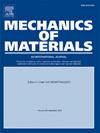名义均质金属中数字体积相关性的探索
IF 3.4
3区 材料科学
Q2 MATERIALS SCIENCE, MULTIDISCIPLINARY
引用次数: 0
摘要
利用x射线计算机断层扫描(XCT)对名义上均质金属进行数字体积相关(DVC)的能力通过合成和实验技术的结合进行了检验。DVC需要在体积内跟踪标记,我们首先讨论了在x射线扫描中增强名义上均质金属固有不均匀性引起的灰度变化的方法。利用这些增强扫描,我们通过综合施加刚性运动和复杂位移场的组合来验证DVC算法的预测。刚体运动很容易被捕获,因为场是由试样边界的运动控制的,其中金属和空气之间存在高灰度对比度。没有边界运动的局部变形场需要高质量的层析扫描,我们探索了提供高保真度预测的超参数范围。然后将研究推广到实验得到的实际位移场。一个关键的结论是,通过施加合成位移场来优化的超参数通常是不合适的。这是因为由于金属的实际变形而引起的图像灰度变化与用于施加合成变形的算法中假设的变化不同。结合不同的标本几何形状和已知的标本物理行为,我们在自然使用边界信息的全局DVC算法中重新优化超参数。最后,我们还探讨了“硬件”方法来改进DVC预测。我们的结果显示出了希望,并为进一步改进提供了建议。本文章由计算机程序翻译,如有差异,请以英文原文为准。
Exploration of digital volume correlation in nominally homogeneous metals
The ability to conduct digital volume correlation (DVC) in nominally homogeneous metals using X-ray computed tomography (XCT) is examined by a combination of synthetic and experimental techniques. DVC requires markers to track within the volume and we first discuss methods by which the grayscale variations due to inherent inhomogeneities in nominally homogeneous metals can be enhanced in X-ray scans. Using these enhanced scans we then validate the predictions of the DVC algorithm via a combination of synthetically imposed rigid motions and complex displacement fields. The rigid body motions are captured very easily as the fields are dominated by motion of the specimen boundaries where a high grayscale contrast exists between the metal and air. The local deformation fields where there is no boundary motion require high quality tomographic scans, and we explore the range of hyperparameters that give high fidelity predictions. The study is then extended to real displacement fields obtained from experiments. A key conclusion is that hyperparameters optimised by imposing synthetic displacement fields are often inappropriate. This is because the changes to the image grayscales that occur due to the actual deformation of metals are different from those assumed in the algorithms used to impose synthetic deformations. Using a combination of different specimen geometries and known physical behaviour of the specimens, we reoptimise the hyperparameters in a global DVC algorithm that naturally uses boundary information. Finally, we also explore “hardware” methods to improve the DVC predictions. Our results show promise and suggest routes for further improvements.
求助全文
通过发布文献求助,成功后即可免费获取论文全文。
去求助
来源期刊

Mechanics of Materials
工程技术-材料科学:综合
CiteScore
7.60
自引率
5.10%
发文量
243
审稿时长
46 days
期刊介绍:
Mechanics of Materials is a forum for original scientific research on the flow, fracture, and general constitutive behavior of geophysical, geotechnical and technological materials, with balanced coverage of advanced technological and natural materials, with balanced coverage of theoretical, experimental, and field investigations. Of special concern are macroscopic predictions based on microscopic models, identification of microscopic structures from limited overall macroscopic data, experimental and field results that lead to fundamental understanding of the behavior of materials, and coordinated experimental and analytical investigations that culminate in theories with predictive quality.
 求助内容:
求助内容: 应助结果提醒方式:
应助结果提醒方式:


